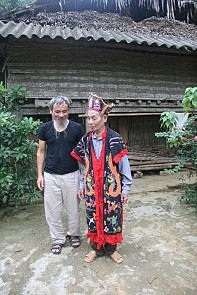Brief meetings between a local culture researcher in September and ethnic shamans in northern Vietnam’s Tuyen Quang Province have shed light on their rich culture, particularly their worship folk paintings.
Phan Cam Thuong, a veteran local culture researcher, visited Ham Yen District, more than 30 km from the province’s heart, where the villages of the Tay ethnic minority community nestle in valleys and along mountain sides.
The community’s unique stilt houses have a certain impact on those erected by other ethnic communities such as the Dao and Cao Lan, which also dot the areas.
Thuong observed that unlike in the past, when it was quite hard to locate shamans, they are now much easier to find as most of them work or used to work for grassroots administrative agencies.
Thuong travelled several hours to reach Truong Van Dam, a Dao shaman and a commune official, at his home.
According to Dam, during the war and the post-war years, there was no room for his and other ethnic communities’ religions to be practiced, as they were dismissed as superstitions by the government.
Fortunately, the 21st century has seen a revival of the ethnic cultural values and religions, which he and other shamans have helped restore.
According to Thuong, the long-standing religions practiced by such ethnic minorities as the Dao, Tay, Nung, Cao Lan and San Chi bear notable influence from Chinese religions, and were later slightly fused with Buddhism.
Studies show that the Dao community boasts among the most traditional tomes, mostly in the form of religious, ritual, medicinal and calendar books.
Most are written in Han - an ancient Chinese script - and the Dao people’s own dialect, which is adapted from ancient Vietnamese.
The shaman added that most of the books, which keep detailed records of their rituals, customs and knowledge, have been passed on from one generation to the next, particularly during their migration from southern China to Vietnam a long time ago.
An indispensable part of the Dao’s, as well as other groups’, rituals is their worship folk paintings, he noted.
No one can tell exactly which paintings belong to which ethnic community, as they bear striking resemblances.
They mostly differ slightly in the rituals, the shaman pointed out.
He also expressed concern that rampant trading of the paintings since the 1960s has taken a heavy toll on the communities’ priceless art heritage, though a number of such paintings are preserved at local museums.
Most of them are currently available on the local market, even in cities in other countries, including New York.
Back in the 1990s, a worship folk painting was worth as much as a work by an artist, but today such paintings can be purchased in bulk for low prices in ethnic villages.
Shaman Dam then advised Thuong and his research team to visit another revered Cao Lan shaman.
Shaman Thach Duc Dien, who is in his 80s, showcased all his books and paintings.
Dien noted that his community’s worship books vary considerably from book to book, and even from reader to reader.
Meanwhile, Shaman Sam Van Ut, of the Tay ethnic minority, still has his treasured age-old worship and calendar books.
Several of his tomes, which are yellowed or tattered, have been handed down from up to seven generations, or around 200 years.
























































